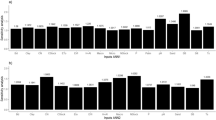Abstract
A hybrid neuro-fuzzy approach called the NUFZY system, which embeds fuzzy reasoning into a triple-layered network structure, has been developed to identify nonlinear systems. A set of membership functions at the input layer is partially linked with a layer of rules, using pre-set parameters. By means of a simplified centroid of gravity defuzzification method, the output becomes linear in the weights. Therefore, very fast estimation of the weight parameters can be achieved by using the orthogonal least squares (OLS) method, which also provides a method to efficiently remove the redundant fuzzy rules from the prototype rule base of the NUFZY system. In this paper, the NUFZY system is applied to identify lettuce growth and greenhouse temperature from real experimental data.
Results show that the NUFZY model with the fast OLS training can perform quite well in predicting both lettuce growth and greenhouse temperature. In contrast to the mechanistic modeling procedures, the neuro-fuzzy approach offers an easier route and a fast way to build the nonlinear mapping of inputs and outputs. In addition, the resulting internal network structure of the NUFZY system is a self-explanatory representation of fuzzy rules. Under this frame, it is a perspective that one is able to incorporate the human knowledge in this approach, and, hopefully, to deduce any interpretable rules that describe the systems' behavior.
Similar content being viewed by others
References
van Henten, E. J. (1994). Greenhouse Climate Management: An Optimal Control Approach. PhD thesis, Wageningen Agricultural University, Wageningen, The Netherlands.
Narendra, K. S. & Parthasarathy, K. (1990). Identification and Control of Dynamical Systems Using Neural Networks. IEEE Trans. Neural Networks 1: 4–27.
Wang, L. X. & Mendel, J. M. (1992). Fuzzy Basis Function, Universal Approximation, and Orthogonal Least-Squares Learning. IEEE Trans. Neural Networks 3: 807–814.
Castro, J. L. (1995). Fuzzy Controller Are Universal Approximators. IEEE Trans. Syst., Man, Cybern 25: 629–635.
Takagi, T. & Sugeno, M. (1985). Fuzzy Identification of Systems and Its Applications to Modeling and Control. IEEE Trans. Syt., Man, Cybern 15: 116–132.
Sugeno, M. & Tanaka, K. (1991). Successive Identification of a Fuzzy Model and Its Applications to Prediction of a Complex System. Fuzzy Sets and Systems 42: 315–334.
Lin, C. T. & Lee, C. S. G. (1991). Neural-Network-Based Fuzzy Logic Control and Decision System. IEEE Trans. Computers 40: 1320–1336.
Horikawa, S. I., Furuhashi, T. & Uchikawa, Y. (1992). On Fuzzy Modeling Using Fuzzy Neural Networks with the Back-Propagation Algorithm. IEEE Trans. Neural Networks 3: 801–806.
Jang, J. S. R. (1993). ANFIS: Adaptive-Network-Based Fuzzy Inference Systems. IEEE Trans. Syst., Man, Cybern 23: 665–685.
Hauptmann, W. & Heesche, K. (1994). A Prototype of an Integrated Fuzzy-Neuro System. In Proc. EUFIT'94 2nd European Congress on Fuzzy and Intelligent Technologies, 1101–1104. Aachen, Germany, September 20–23.
Tien, B. T. & van Straten, G. (1995). Neural-Fuzzy Systems for Non-Linear System Identification – Orthogonal Least Squares Training Algorithms and Fuzzy Rule Reduction. In Prepring of the 2nd IFAC/IFIP/EurAgEng Workshop on AI in Agriculture, 249–254. Wageningen, The Netherlands, May 29–31.
Tien, B. T. & van Straten, G. (1996). Recursive Prediction Error Algorithm for the NUFZY System to Identify Nonlinear Systems. In Proceedings of the 9th International Conference on Industrial and Engineering Applications of Artifical Intelligence and Expert Systems IEA/AIE96, 569–574. Fukuoka, Japan, June 4–7.
Challa, H. (1989). Modeling for Crop Growth Control. Acta Horitculturae 248: 209–216.
Chen, S., Cowan, C. F. N. & Grant, P. M. (1991). Orthogonal Least Squares Learning Algorithm for Radial Basis Function Networks. IEEE Trans. Neural Networks 2: 302–309.
Udink ten Cate, A. J. (1985). Modeling and Simulation in Greenhouse Climate Control. Acta Horticulturae 174: 461–467.
Tchamitchian, M., van Willigenburg, L. G. & van Straten, G. (1993). Short Term Dynamic Optimal Control of the Greenhouse Climate. Wageningen Agricultural University, Dept. of Agricultural Engineering and Physics, MRS-report 92–3, 22 pp.
Tap, R. F., van Willigenburg, L. G. & van Straten, G. (1995). Experimental Results of Receding Horizon Optimal Control of Greenhouse Climate. Acta Horiticulturae 406: 229–238.
Tap, R. F. (1996). Receding Horizon Optimal Control of Greenhouse Climate. In Preparation.
Wang, L. X. (1994). Adaptive Fuzzy Systms and Control – Design and Stability Analysis. Prentice-Hall: Englewood Cliffs, New Jersey.
Author information
Authors and Affiliations
Rights and permissions
About this article
Cite this article
Tien, B., Van Straten, G. A Neuro-Fuzzy Approach to Identify Lettuce Growth and Greenhouse Climate. Artificial Intelligence Review 12, 71–93 (1998). https://doi.org/10.1023/A:1006592422202
Issue Date:
DOI: https://doi.org/10.1023/A:1006592422202




